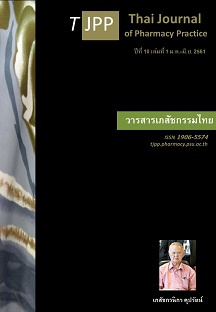ปัจจัยที่มีความสัมพันธ์กับความร่วมมือในการใช้ยาสำหรับผู้ป่วยเด็ก โรคข้ออักเสบไม่ทราบสาเหตุ ณ สถาบันสุขภาพเด็กแห่งชาติมหาราชินี
Main Article Content
บทคัดย่อ
วัตถุประสงค์: เพื่อค้นหาปัจจัยที่มีความสัมพันธ์กับความร่วมมือในการใช้ยาสำหรับผู้ป่วยเด็กโรคข้ออักเสบไม่ทราบสาเหตุ ที่เข้ารับบริการที่คลินิกภูมิแพ้และโรคข้อ สถาบันสุขภาพเด็กแห่งชาติมหาราชินี วิธีการ: ผู้ดูแลของผู้ป่วยที่ได้รับยามาแล้วอย่างน้อย 3 เดือน จำนวน 76 รายได้รับการคัดเลือกให้เข้าสู่การศึกษา การศึกษาแบบไปข้างหน้านี้ประเมินความร่วมมือในการใช้ยาจากทั้งการนับเม็ดยาหรือปริมาณยา และแบบบันทึกวันและเวลาที่ผู้ดูแลของผู้ป่วยเด็กจัดยาให้จากการติดตามการใช้ยาเป็นเวลา 1-2 เดือน โดยแบ่งเป็นความร่วมมือในการใช้ยาระดับดีและระดับต่ำซึ่งมีความร่วมมือในการใช้ยาโดยรวมตั้งแต่ร้อยละ 80 ขึ้นไป และน้อยกว่าร้อยละ 80 ตามลำดับ ปัจจัยที่เกี่ยวกับผู้ป่วยที่ศึกษา ได้แก่ เพศ อายุ ความซับซ้อนของรายการยา และการไม่มีโรคเรื้อรังอื่นร่วมด้วย การศึกษาเก็บข้อมูลเหล่านี้จากเวชระเบียนของผู้ป่วย ส่วนปัจจัยเกี่ยวกับผู้ดูแลในครอบครัวของผู้ป่วยที่ศึกษา ได้แก่ รายได้ของครอบครัว ระดับการศึกษา ความรู้ อุปสรรคและทัศนคติต่อการใช้ยา ข้อมูลเหล่านี้เก็บโดยใช้การสัมภาษณ์ผู้ดูแลโดยใช้แบบสอบถาม สำหรับความรู้ อุปสรรค และทัศนคติต่อการใช้ยาวัดโดยการใช้แบบวัดความร่วมมือในการใช้ยาที่พัฒนาโดย Wu และคณะ ผลการวิจัย: ผู้ป่วยมีความร่วมมือในการใช้ยาระดับดี จำนวน 55 ราย (ร้อยละ 72.4) เมื่อวิเคราะห์ด้วยสถิติถดถอยแบบโลจิสติกส์ พบว่าทัศนคติเชิงบวกของผู้ดูแลต่อการใช้ยา (odds ratio หรือ OR=3.7, P=0.026) และการไม่มีโรคเรื้อรังอื่นร่วมด้วย (OR=6.5, P=0.010) เป็นตัวทำนายความร่วมมือในการใช้ยาระดับดีได้อย่างมีนัยสำคัญ สรุป: การปรับเปลี่ยนทัศนคติต่อการใช้ยาของผู้ดูแลน่าจะช่วยให้ผู้ป่วยเด็กโรคข้ออักเสบไม่ทราบสาเหตุมีความร่วมมือในการใช้ยาที่ดีขึ้นได้ อย่างไรก็ตามควรมีการศึกษาเพิ่มเติมเพื่อสำรวจปัจจัยสำคัญที่เกี่ยวข้องกับความร่วมมือในการใช้ยาอย่างเต็มที่มากขึ้นในผู้ป่วยกลุ่มนี้
Article Details
ผลการวิจัยและความคิดเห็นที่ปรากฏในบทความถือเป็นความคิดเห็นและอยู่ในความรับผิดชอบของผู้นิพนธ์ มิใช่ความเห็นหรือความรับผิดชอบของกองบรรณาธิการ หรือคณะเภสัชศาสตร์ มหาวิทยาลัยสงขลานครินทร์ ทั้งนี้ไม่รวมความผิดพลาดอันเกิดจากการพิมพ์ บทความที่ได้รับการเผยแพร่โดยวารสารเภสัชกรรมไทยถือเป็นสิทธิ์ของวารสารฯ
เอกสารอ้างอิง
2. Cordingley L, Vracas T, Baildam E, Chieng A, Davidson J, Foster HE, et al. Juvenile-onset inflamema tory arthritis: a study of adolescents’ beliefs about underlying cause. J Rheumatol 2012; 51: 2239-45.
3. Pelajo CF, Sgarlat CM, Lopez-Benitez JM, Oliveira SKF, Rodrigues MCF, Sztajnbok FR, et al. Adherence to methotrexate in juvenile idiopathic arthritis. Rheumatol Int 2012; 32: 497-500.
4. Len CA, Miotto e Silva VB, Terreri MTRA. Importance of adherence in the outcome of juvenile idiopathic arthritis. Curr Rheumatol Rep 2014; 16: 410-7.
5. Bugni VM, Ozaki LS, Okamoto KY, Barbosa CM, Hilario OE, Len CA, et al. Factors associated with adherence to treatment in children and adolescents with chronic rheumatic diseases. J Pediatr (Rio J) 2012; 88: 483-8.
6. April KT, Feldman DE, Platt RW, Duffy MC. Comparison between children with juvenile idiopathic arthritis and their parents concerning perceived treatment adherence. Arthritis Care Res 2006; 55: 558-63.
7. World Health Organization. Adherence to long-term therapies: evidence for action [online]. 2003 [cited Aug 13, 2015]. Available from: http://www.who.int/ chp/knowledge/publications/adherence_full_report.pdf.
8. Prudente LR, Diniz JS, Ferreira TXAM, Lima DM, Silva NA, Saraiva G, et al. Medication adherence in patients in treatment for rheumatoid arthritis and systemic lupus erythematosus in a university hospital in Brazil. Patient Prefer Adherence 2016; 10: 863–70.
9. Mongkolchaipak T. Factors affecting medication adherence of diabetic patients at Police General Hospital. Thai Journal of Pharmacy Practice 2015; 7: 47-59.
10. Elliott RA. Poor adherence to medication in adult with rheumatoid arthritis. Dis Manage Health Outcomes 2008; 16: 13-29.
11. Chanachai K. Factors affecting the medication compliance of elderly patients with chronic diseases at Namkleang Hospital, Namkleang District, Sisaket Province. Research and Development Health System Journal 2015; 8: 287-91.
12. Pimratana W. Associations between caretakers’ attitude, caretakers’ knowledge of attention deficit hyperactivity disorder (ADHD) and child patients’ compliance to take methylphenidate (MPH). J Psychiatr Assoc Thailand 2016; 61: 15-26.
13. Salt E, Frazie SK Predictors of medication adherence in patients with rheumatoid arthritis. Drug Dev Res 2011; 72: 756–63.
14. Wu JR, Moser DK, Chung ML, Lennie TA. Predictors of medication adherence using a multidimensional adherence model in patients with heart failure. J Card Failure 2008; 14: 603-14.
15. Wungthanakorn S, Phatidumrongkul C, Khomchan P. Factors affecting medication taking behaviors in hypertensive patients. Songklanagarind Medical Journal 2008; 26: 539-47.
16. Viller F, Guillemin F, Briancon S, Moum T, Suurmeijer T, van den Heuvel W. Compliance to drug reatment of patients with rheumatoid arthritis: a 3 year longitudinal study. J Rheumatol 1999; 26: 2114-22.
17. Buasai M, Jirapaet V. Selected factors predicting antiretroviral drug adherence in school-age children with HIV-Infection/Aids. Journal of the Royal Thai Army Nurses 2012. 13: 28-37.
18. Salt E, Frazier S. Adherence to disease modifying anti-rheumatic drugs in rheumatoid arthritis patients : A narrative review of the literature. Orthop Nurs 2010; 29: 260-75.
19. Yuenyaw M, Thampanichawat W, Nookong A. Predictors of adherence to antiretroviral medication in children with HIV Infection. J Nurs Sci 2012; 30: 80-9.
20. Peduzzi P, Concato J, Kemper E, Holford TR, Feinstein AR. A simulation study of the number of events per variable in logistic regression analysis. J Clin Epidemiol 1996; 49; 1373-79.
21. Wu JR, Chung M, Lennie TA, Hall LA, Moser DK. Testing the psychometric properties of the medication adherence scale in patients with heart failure. Heart Lung 2008; 37: 334-43.
22. Sukhvibul T. Considerations in creating rating scale [online]. 2009 [cited Aug 20, 2016]. Available from: ms.src.ku.ac.th/schedule/Files/2553/Oct/1217 086.doc
23. van den Bemt BJF, Zwikker HE, van den Ende CHM. Medication adherence in patients with rheu- matoid arthritis: a critical appraisal of the existing literature. Expert Rev Cli Immunol 2012; 8: 337-51.
24. Rapoff MA, Belmont J, Lindsley C, et al. Prevention of nonadherence to nonsteroidal anti-inflammatory medications for newly diagnosed patients with juvenile rheumatoid arthritis. Health Psychol 2002; 21: 620–3.
25. Joplin S, van der Zwan R, Joshua F. Wong PKK. Medication adherence in patients with rheumatoid arthritis: the effect of patient education, health literacy, and musculoskeletal ultrasound. BioMed Research International 2015: 1-11.
26. Stark LJ, Janicke DM, McGrath AM. Prevention of Osteoporosis: A randomized clinical trial to increase calcium intake in children with juvenile rheumatoid arthritis. J Pediatr Psychol 2005; 30: 377-86.
27. Hommel KA, Hente EA, Odell S, Herzer M, Ingerski LM, Guilfoyle SM, et al. Evaluation of a group-based behavioral intervention to promote adherence in adolescents with inflammatory bowel disease. Eur J Gastroenterol Hepatol 2012; 24: 64-9.
28. Vittinghoff E, McCulloch CE. Relaxing the rule of ten events per variable in logistic and cox regression. Am J Epidemiol 2007; 165: 710–8.


